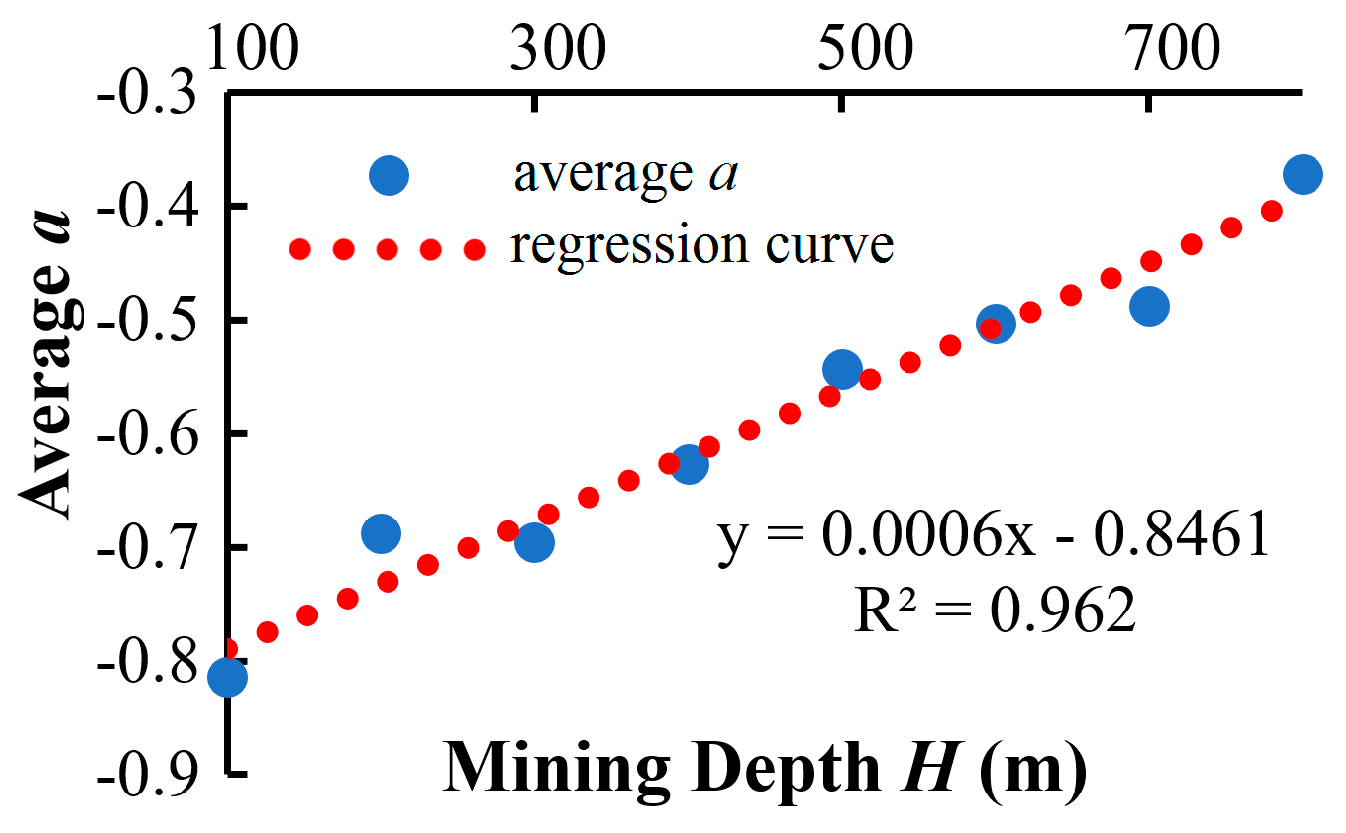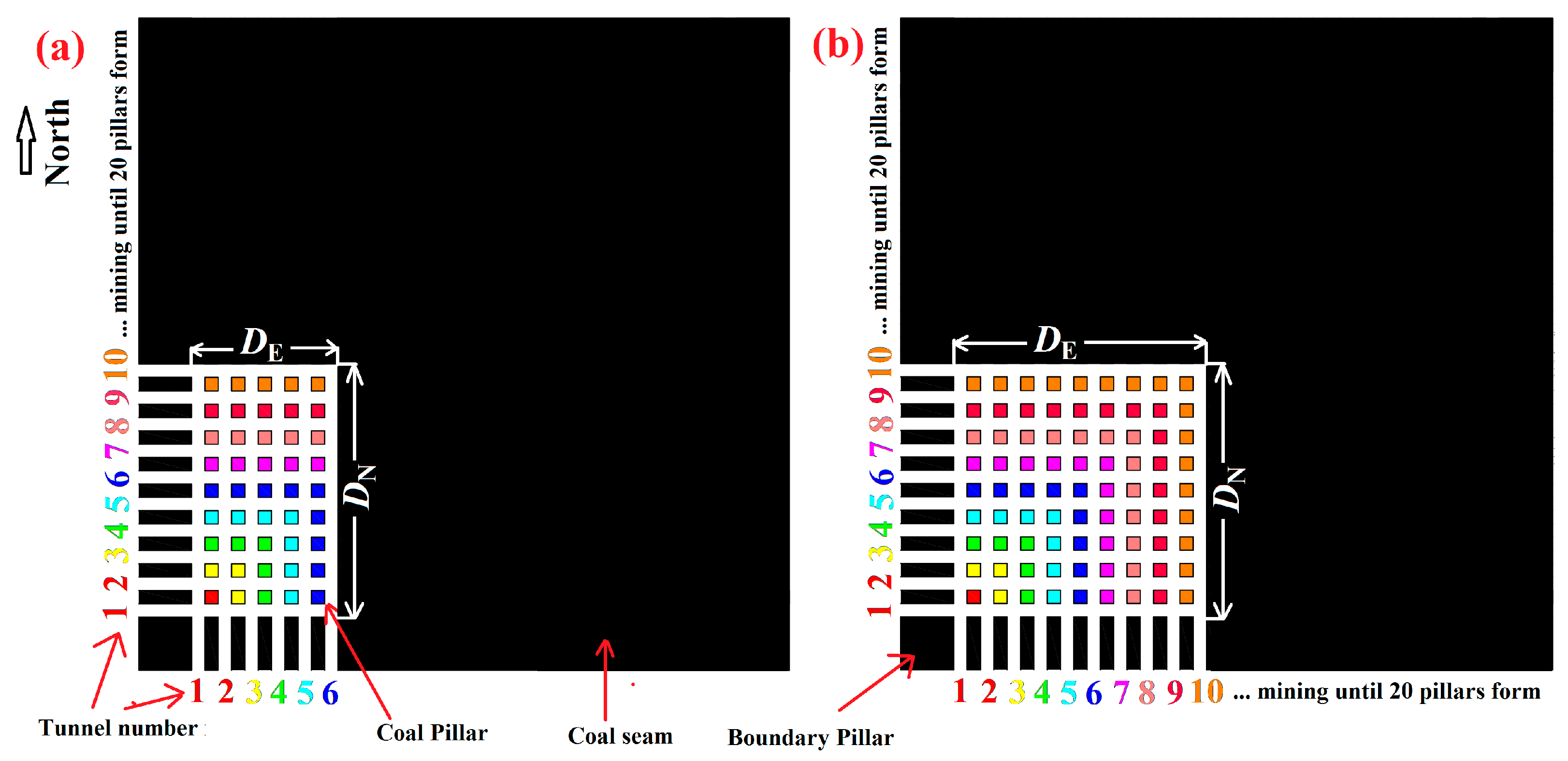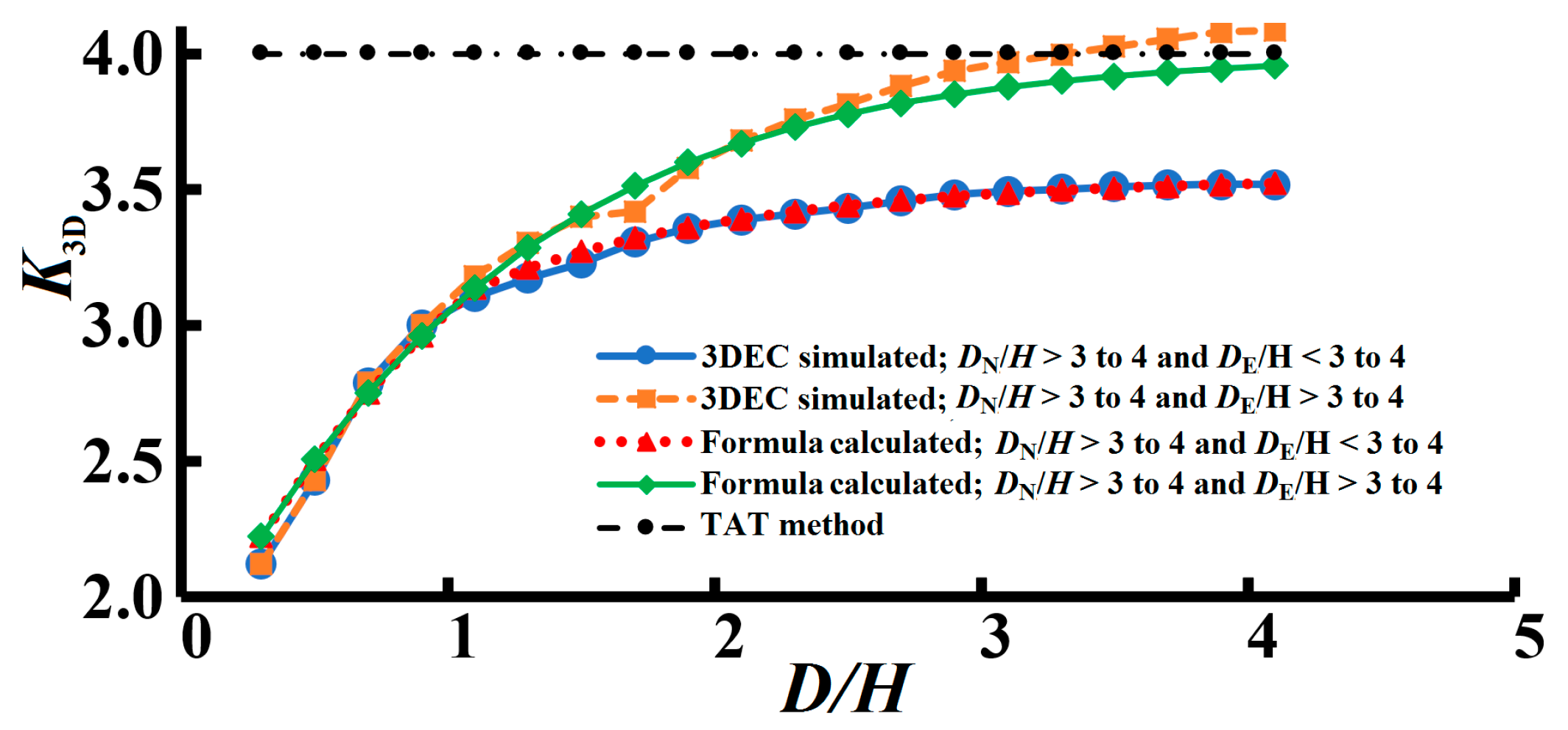Mine Size Effects on Coal Pillar Stress and Their Application for Partial Extraction
Abstract
:1. Introduction
2. Mine Modeling and Simulation
3. Analysis of Simulation Results
3.1. Effects of the Mine Size on the Maximum Vertical Pillar Stress of the Mine
3.2. Effects of on the Maximum Vertical Pillar Stress of the Mine
3.3. Effects of Overburden Properties on the Maximum Vertical Pillar Stress of the Mine
4. Mine Size Effect on 3D Partial Extraction
5. Discussion
6. Conclusions
Acknowledgments
Author Contributions
Conflicts of Interest
References
- Can, E.; Kuşcu, Ş.; Kartal, M.E. Effects of mining subsidence on masonry buildings in Zonguldak hard coal region in Turkey. Environ. Earth Sci. 2012, 66, 2503–2518. [Google Scholar] [CrossRef]
- Deliormanli, A.H. Assessment of coal mining subsidence damage in Soma-Turkey coalfield using FEM modelling. Arch. Min. Sci. 2012, 57, 179–192. [Google Scholar]
- Ghabraie, B.; Ren, G.; Barbato, J.; Smith, J.V. A predictive methodology for multi-seam mining induced subsidence. Int. J. Rock Mech. Min. 2017, 93, 280–294. [Google Scholar] [CrossRef]
- Wang, H.; Zhang, D.; Wang, X.; Zhang, W. Visual exploration of the spatiotemporal evolution law of overburden failure and mining-induced fractures: A case study of the Wangjialing coal mine in China. Minerals 2017, 7, 35. [Google Scholar] [CrossRef]
- Yu, Y.; Chen, S.E.; Deng, K.Z.; Wang, P.; Fan, H.D. Subsidence mechanism and stability assessment methods for partial extraction mines for sustainable development of mining cities—A review. Sustainability 2018, 10, 113. [Google Scholar] [CrossRef]
- Chen, S.; Wang, H.; Wang, H.; Guo, W.; Li, X. Strip coal pillar design based on estimated surface subsidence in eastern China. Rock Mech. Rock Eng. 2016, 49, 1–10. [Google Scholar]
- Guo, W.; Wang, H.; Chen, S. Coal pillar safety and surface deformation characteristics of wide strip pillar mining in deep mine. Arab. J. Geosci. 2016, 9, 1–9. [Google Scholar] [CrossRef]
- Chong, L.; Xu, J.; Wang, Z.; Shuai, Q. Domino instability effect of surrounding rock-coal pillars in a room-and-pillar gob. Int. J. Min. Sci. Technol. 2013, 23, 913–918. [Google Scholar]
- Dehghan, S.; Shahriar, K.; Maarefvand, P.; Goshtasbi, K. 3-D numerical modelling of domino failure of hard rock pillars in Fetr6 Chromite Mine, Iran, and comparison with empirical methods. J. Cent. South Univ. 2013, 20, 541–549. [Google Scholar] [CrossRef]
- Wilson, A.H. The stability of underground workings in the soft rocks of the coal measures. Int. J. Min. Eng. 1983, 1, 91–187. [Google Scholar] [CrossRef]
- Roberts, D.P.; Merwe, J.V.D.; Canbulat, I.; Sellers, E.J.; Coetzer, S. Development of a Method to Estimate Coal Pillar Loading. 2002. Available online: http://www.mhsc.org.za/sites/default/files/COL%20709%20Final%20Report.pdf (accessed on 23 January 2018).
- Jaiswal, A.; Sharma, S.K.; Shrivastva, B.K. Numerical modeling study of asymmetry in the induced stresses over coal mine pillars with advancement of the goaf line. Int. J. Rock Mech. Min. 2004, 41, 859–864. [Google Scholar] [CrossRef]
- Jayanthu, S.; Singh, T.N.; Singh, D.P. Stress distribution during extraction of pillars in a thick coal seam. Rock Mech. Rock Eng. 2004, 37, 171–192. [Google Scholar] [CrossRef]
- Hauquin, T.; Deck, O.; Gunzburger, Y. Average vertical stress on irregular elastic pillars estimated by a function of the relative extraction ratio. Int. J. Rock Mech. Min. 2016, 83, 122–134. [Google Scholar] [CrossRef]
- Luo, Y. Room-and-pillar panel design method to avoid surface subsidence. Min. Eng. 2015, 67, 105–110. [Google Scholar]
- Poulsen, B.A. Coal pillar load calculation by pressure arch theory and near field extraction ratio. Int. J. Rock Mech. Min. 2010, 47, 1158–1165. [Google Scholar] [CrossRef]
- Mark, C. Analysis of Longwall Pillar Stability. Ph.D. Thesis, Pennsylvania State University, University Park, State College, PA, USA, 1987. [Google Scholar]
- Singh, A.K.; Singh, R.; Maiti, J.; Kumar, R.; Mandal, P.K. Assessment of mining induced stress development over coal pillars during depillaring. Int. J. Rock Mech. Min. 2011, 48, 805–818. [Google Scholar] [CrossRef]
- Suchowerska, A.M.; Merifield, R.S.; Carter, J.P. Vertical stress changes in multi-seam mining under supercritical longwall panels. Int. J. Rock Mech. Min. 2013, 61, 306–320. [Google Scholar] [CrossRef]
- Rezaei, M.; Hossaini, M.F.; Majdi, A. Determination of longwall mining-induced stress using the strain energy method. Rock Mech. Rock Eng. 2015, 48, 2421–2433. [Google Scholar] [CrossRef]
- Du, X.L.; Song, H.W.; Chen, J. Numerical simulation of the evolution of the pressure arch during coal mining. J. China Univ. Min. Technol. 2011, 40, 863–867. (In Chinese) [Google Scholar]
- Mark, C. Science of empirical design in mining ground control. Int. J. Min. Sci. Technol. 2016, 26, 461–470. [Google Scholar] [CrossRef]
- He, G.Q.; Yang, L.; Ling, G.D.; Jia, F.C.; Hong, D. Mine Subsidence Science; China University of Mining and Technology Press: Xuzhou, China, 1994. (In Chinese) [Google Scholar]
- Shi, B. Study on Influence Factors of Water Conservation Mining in Shallow Seam Mine Area in the North Shaanxi Province. Ph.D. Thesis, Xi’an University of Science and Technology, Xi’an, China, 2012. (In Chinese). [Google Scholar]







| 100 | 14 | 10 | 1066 | 0.71 | 200 | 17 | 20 | 1093 | 1.18 | 300 | 75 | 1575 | 1 | |
| 12 | 10 | 516 | 0.83 | 14 | 20 | 1006 | 1.43 | 400 | 54 | 40 | 2108 | 0.74 | ||
| 10 | 1510 | 1 | 10 | 20 | 1190 | 2 | 40 | 1560 | 1 | |||||
| 9 | 10 | 656 | 1.11 | 7 | 20 | 1073 | 2.86 | 20 | 40 | 2080 | 2 | |||
| 5 | 10 | 670 | 2 | 23 | 1587 | 1 | 45 | 1575 | 1 | |||||
| 12 | 1620 | 1 | 25 | 1525 | 50 | 1550 | ||||||||
| 13 | 1573 | 29 | 1537 | 57 | 1539 | |||||||||
| 15 | 1575 | 34 | 1530 | 67 | 1541 | |||||||||
| 17 | 1547 | 41 | 1517 | 80 | 1520 | |||||||||
| 20 | 1500 | 67 | 50 | 1454 | 0.75 | 50 | 100 | 2050 | 2 | |||||
| 34 | 25 | 1146 | 0.74 | 50 | 1550 | 1 | 100 | 1500 | 1 | |||||
| 25 | 1525 | 1 | 25 | 50 | 1475 | 2 | 134 | 100 | 2206 | 0.75 | ||||
| 13 | 25 | 1127 | 1.92 | 300 | 15 | 30 | 1650 | 2 | 500 | 50 | 1550 | 1 | ||
| 200 | 7 | 1127 | 1 | 20 | 30 | 1680 | 1.5 | 56 | 1512 | |||||
| 8 | 1288 | 25 | 30 | 1735 | 1.2 | 63 | 1575 | |||||||
| 9 | 1449 | 30 | 1530 | 1 | 72 | 1512 | ||||||||
| 10 | 1510 | 35 | 30 | 1785 | 0.86 | 84 | 1596 | |||||||
| 11 | 1507 | 40 | 30 | 1780 | 0.75 | 100 | 1500 | |||||||
| 13 | 1521 | 34 | 1530 | 1 | 125 | 1625 | ||||||||
| 15 | 1515 | 38 | 1558 | 600 | 60 | 3060 | ||||||||
| 27 | 20 | 1195 | 0.74 | 43 | 1505 | 700 | 70 | 3570 | ||||||
| 24 | 20 | 1076 | 0.83 | 50 | 1550 | 800 | 80 | 4080 | ||||||
| 20 | 1500 | 1 | 60 | 1500 | ||||||||||
| Strata | (MPa) | (MPa) | (°) | (GPa) | (kg/m3) | |
|---|---|---|---|---|---|---|
| Sandstone | 6.36 | 11.6 | 34.6 | 15.1 | 0.15 | 2370 |
| Coal | 0.72 | 2.61 | 42 | 2.2 | 0.27 | 1290 |
| Interface | 0.72 | 2.61 | 42 |
| R | R | R | ||||||||||||
|---|---|---|---|---|---|---|---|---|---|---|---|---|---|---|
| 100 | 10 | −0.811 | 1.96 | 0.99 | 200 | 23 | −0.677 | 1.84 | 0.99 | 400 | 50 | −0.665 | 2.00 | 0.99 |
| 12 | −0.773 | 1.92 | 25 | −0.715 | 1.95 | 57 | −0.676 | 2.00 | ||||||
| 13 | −0.833 | 1.96 | 39 | −0.724 | 1.94 | 67 | −0.666 | 1.85 | 0.98 | |||||
| 15 | −0.816 | 1.89 | 34 | −0.709 | 1.92 | 0.98 | 80 | −0.565 | 1.74 | 0.99 | ||||
| 17 | −0.821 | 1.95 | 41 | −0.716 | 1.92 | 100 | −0.56 | 1.82 | ||||||
| 20 | −0.811 | 1.84 | 0.98 | 50 | −0.706 | 1.91 | 500 | 50 | −0.627 | 2.03 | ||||
| 25 | −0.834 | 1.92 | 300 | 30 | −0.682 | 1.97 | 0.99 | 56 | −0.536 | 1.77 | ||||
| 200 | 7 | −0.729 | 2.06 | 0.99 | 34 | −0.69 | 1.96 | 63 | −0.589 | 1.86 | ||||
| 8 | −0.599 | 1.79 | 38 | −0.697 | 1.96 | 0.99 | 72 | −0.507 | 1.75 | 0.98 | ||||
| 9 | −0.673 | 2.00 | 43 | −0.724 | 1.82 | 0.98 | 84 | −0.531 | 1.85 | 0.99 | ||||
| 10 | −0.652 | 1.98 | 50 | −0.687 | 1.95 | 100 | −0.511 | 1.83 | 0.98 | |||||
| 11 | −0.728 | 1.98 | 60 | −0.648 | 1.81 | 0.97 | 125 | −0.505 | 1.95 | 0.99 | ||||
| 13 | −0.666 | 1.98 | 75 | −0.739 | 1.80 | 0.96 | 600 | 60 | −0.504 | 1.86 | ||||
| 15 | −0.664 | 1.90 | 400 | 40 | −0.594 | 1.76 | 0.99 | 700 | 70 | −0.488 | 2.01 | 0.97 | ||
| 20 | −0.674 | 1.87 | 45 | −0.662 | 2.00 | 800 | 80 | −0.372 | 1.75 | 0.95 |
| 1 + | |||||||
|---|---|---|---|---|---|---|---|
| 100 | −0.81 | 1.92 | 500 | −0.54 | 1.86 | 2 | |
| 200 | −0.69 | 1.93 | 600 | −0.50 | 1.86 | ||
| 300 | −0.70 | 1.90 | 700 | −0.49 | 2.01 | ||
| 400 | −0.63 | 1.88 | 800 | −0.37 | 1.75 |
| R | R | ||||||||||
|---|---|---|---|---|---|---|---|---|---|---|---|
| 100 | 2 | 10 | −2.062 | 2.97 | 0.99 | 100 | 0.83 | 10 | −0.726 | 1.78 | 0.98 |
| 1.92 | 25 | −2.135 | 2.84 | 200 | 20 | −0.502 | 1.56 | 0.99 | |||
| 200 | 2 | 20 | −1.972 | 3.07 | 0.98 | 300 | 0.86 | 30 | −0.501 | 1.79 | |
| 50 | −2.343 | 3 | 0.99 | 100 | 0.71 | 10 | −0.509 | 1.69 | |||
| 300 | 30 | −2.078 | 3.34 | 100 | 0.74 | 25 | −0.41 | 1.71 | |||
| 400 | 40 | −2.04 | 3.27 | 200 | 20 | −0.477 | 1.69 | ||||
| 100 | −1.852 | 3.07 | 200 | 0.74 | 50 | −0.446 | 1.67 | 0.94 | |||
| 300 | 1.5 | 30 | −1.179 | 2.4 | 300 | 30 | −0.368 | 1.55 | 0.99 | ||
| 200 | 1.43 | 20 | −1.161 | 2.42 | 400 | 0.74 | 40 | −0.41 | 1.71 | ||
| 100 | 1.11 | 10 | −0.964 | 2.09 | 0.98 | 0.75 | 100 | −0.329 | 1.68 | 0.95 | |
| 200 | 1.18 | 20 | −0.968 | 2.16 | 0.99 | ||||||
| 300 | 1.2 | 30 | −0.911 | 2.21 |
| Average | Average | Average | Average | 1 + |
|---|---|---|---|---|
| 1.99 | 243 | −2.07 | 3.11 | 2.99 |
| 1.47 | 250 | −1.17 | 2.41 | 2.47 |
| 1.16 | 200 | −0.95 | 2.15 | 2.26 |
| 1 | 240 | −0.71 | 1.91 | 2 |
| 0.84 | 200 | −0.58 | 1.71 | 1.84 |
| 0.74 | 243 | −0.41 | 1.66 | 1.74 |
| Poisson’s Ratio Effect = 15 GPa | Elastic Modulus Effect = 0.15 | |||||||
|---|---|---|---|---|---|---|---|---|
| R | /(1 +) | R | ||||||
| 0.1 | −0.7352 | 1.909 | 0.98 | 2 | −0.3258 | 1.629 | 81% | 0.96 |
| 0.2 | −0.7388 | 1.908 | 0.99 | 4 | −0.4092 | 1.742 | 87% | |
| 0.3 | −0.736 | 6 | −0.4822 | 1.803 | 90% | 0.97 | ||
| 0.4 | −0.7623 | 8 | −0.5477 | 1.842 | 92% | 0.98 | ||
| 0.49 | −0.7702 | 30 | −0.8391 | 1.945 | 97% | 0.99 | ||
| 50 | −0.9389 | 1.959 | 98% | |||||
| 70 | −0.9932 | 1.964 | 98% | 0.98 | ||||
| 90 | −1.029 | 1.966 | 98% | |||||
| 100 | −1.04 | 1.965 | 98% | 0.97 | ||||
| Relative Error | Overestimated (+) | Underestimated (−) | Row Sum |
|---|---|---|---|
| [0, 5%] | 826 | 166 | 992 |
| (5%, 10%] | 329 | 45 | 374 |
| (10%, 15%] | 155 | 15 | 170 |
| (15%, 20%] | 53 | 1 | 54 |
| (20%, 25%] | 10 | 0 | 10 |
| (25%, +∞) | 0 | 0 | 0 |
| Column Sum | 1373 | 227 | 1600 |
© 2018 by the authors. Licensee MDPI, Basel, Switzerland. This article is an open access article distributed under the terms and conditions of the Creative Commons Attribution (CC BY) license (http://creativecommons.org/licenses/by/4.0/).
Share and Cite
Yu, Y.; Deng, K.-Z.; Chen, S.-E. Mine Size Effects on Coal Pillar Stress and Their Application for Partial Extraction. Sustainability 2018, 10, 792. https://doi.org/10.3390/su10030792
Yu Y, Deng K-Z, Chen S-E. Mine Size Effects on Coal Pillar Stress and Their Application for Partial Extraction. Sustainability. 2018; 10(3):792. https://doi.org/10.3390/su10030792
Chicago/Turabian StyleYu, Yang, Ka-Zhong Deng, and Shen-En Chen. 2018. "Mine Size Effects on Coal Pillar Stress and Their Application for Partial Extraction" Sustainability 10, no. 3: 792. https://doi.org/10.3390/su10030792





